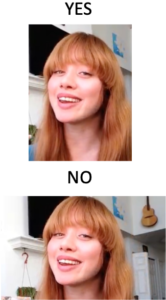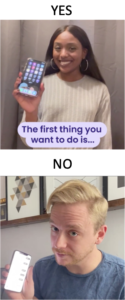
Every marketer worth their salt knows the power of user generated content or UGCs, which is content created about a brand by the brand’s customers.
But how exactly do you create a winning UGC video with high engagement among your users? What are the key details to be kept in mind during the actual process of creating a UGC video, not simply re-sharing something made by one of your users?
In this week’s episode, we dive into the top 10 elements that help craft high-impact UGCs, based on our own experience of creating such videos for our clients.
**
Note: We have a growing community of mobile marketers!
The Mobile Growth Lab Slack: A community that was a part of our workshop series – The Mobile Growth Lab, is now open to the general public. Join over 200 mobile marketers to discuss challenges and share your expertise. More details are available here: https://mobileuseracquisitionshow.com/slack/
If you’re ready to join the growing community, fill this form: https://forms.gle/cRCYM4gT1tdXgg6u5



ABOUT ROCKETSHIP HQ: Website | LinkedIn | Twitter | YouTube
KEY HIGHLIGHTS
🎥 What is UGC?
👨🏽🎤 Find the right user
✅ Determine the best UGC format for you
📱 Shooting with a camera phone
💡 Finding the right lighting for your actor
📸 How to shoot the phone screen
🎥 No shaky cams
📞 How to get clear audio
🖼 The frame is important – so describe it
🖥 Describe the device to be used
👀 Making the UGC looks unscripted
🥽 Expect the unexpected
FULL TRANSCRIPT BELOWINTRODUCTION
Every mobile marketer knows the power of ads based on user generated content or UGCs, or live actor footage, if you will.
We’ve seen these ads perform dramatically well for a number of Rocketship HQ’s clients, and the share of spend on UGC ads has risen significantly over the last one to two years among the apps in our portfolio. Right now, UGCs form a key part of our creative strategy – especially on consumer/subscription apps, but also on games.
With this increasing focus on UGCs, comes the question: what are the best practices and guidelines that you, as a marketing agency or a marketing team of an organization, can follow to ensure you have winning, performant UGCs that can scale?
Because let’s face it – UGC ads can look deceptively easy and yet can be hugely challenging to get right. And oftentimes they can ‘look’ great – but bomb in the marketplace.
After having made, reviewed & analyzed thousands of UGC ads (and falling into the all too common pitfalls of grainy videos, shaky footage and garbled audios), we’ve seen what works and what doesn’t.
This week’s episode is the first of a series in which we give you a peek into our internal UGC process. Today’s episode focuses on planning for and nailing the shoot – and includes the checklist we use internally to ensure we have strong, performant UGC style videos. These are insights that we hope you can use in your own UGC production process – even if you work with and manage an external agency that does your shoots.
Today’s episode is based on insights from Aditya Prakash Iengar, Creative Strategist at RocketShip HQ, who has worked on a lot of these creatives.
1. UNDERSTAND THE USER, THEIR MOTIVATIONS & MESSAGING
This is arguably the most important step, and requires the most amount of time and patience. Since this is a critical step, we’ve dedicated an entire episode to this – and we’ll share that shortly.
But in a nutshell, some of the best ways to understand your users are:
a. Head to your socials and scour through your followers to understand who your ideal users are.
b. Read through app store reviews to understand *why* users are downloading and using your app, what problems they are solving and what their motivations are.
c. Review any user surveys or user research that the app has already done – to understand the ideal user.
This will help you recruit the right kinds of actors or microinfluencers, which is a process that we’ll talk about in an upcoming episode.
2. GET THE VIDEO FORMAT RIGHT
Keep in mind the below considerations about the video format.

- Shoot the video with a smartphone and at least 1080p resolution. Pretty much all mid- to high-end smartphones manufactured in the last 3-4 years can shoot at 1080p. Not only will shooting at this resolution give you sharper, non-grainy footage, it will also give you more options to play with later during the editing process, in case the footage needs to be cropped or zoomed into.
- Decide whether to shoot selfie-style or via a friend: Based on the desired video, the user may at times need a friend to shoot the video – and you may need to specify this for them.

- Shoot in portrait orientation. Most platforms on which UGC ads are the most common – like TikTok, Facebook and Instagram Reels, YouTube Shorts – use the 9:16 aspect ratio, i.e., portrait mode. Moreover, should you want to use the same video in other formats, like Instagram posts for instance, editing the portrait video into a square format will be a breeze.
Note: If you’re planning to publish the video on YouTube as a regular video and not YT Shorts, use landscape orientation. - Use multiple clips. This is the current trend, where different clips for different lines of dialogue are used instead of a single continuous shot. The actor can shoot the entire video in multiple clips, and this can be stitched together in post production.
3. ENSURE THE RIGHT LIGHTING FOR ACTORS
Just as it is “location, location, location” in real estate, so it is “lighting, lighting, lighting” in videos! Its importance cannot be underestimated.
We recommend considering the below points to ensure proper lighting.

- Front: The subject has to face the primary light source. So, if the shoot is indoors, the light has to be behind the camera. For outdoor shoots, the subject must face towards the sun. The light shouldn’t be harsh and directed straight on the face.
- Back: There must be no light source behind the subject, i.e., facing the camera. If there is, the camera will try to adjust the overall frame, and the subject will become too dark. If you still manually focus the camera on the subject, then the light will wash out the entire background. For indoor shoots, ensure that no lamps or bulbs are behind the subject. For outdoor shoots, the subject should position themselves in such a way that the bright sky isn’t visible behind them, and even if it is, it should be minimally visible.
- Often, a light behind the subject can add to the overall composition of the shot, but as a thumb rule, it should be soft, diffused (if possible) and dimmer than the primary light source.
- The same if a screen (desktop, laptop, TV, tablet, etc) is a must behind the subject — its brightness must be dimmed.
4. ENSURE THE PHONE SCREENS ARE CLEAR
Often, you may need the actor to give a walkthrough of an app, or simply show the screen to the camera. Ideally, this should be done indoors, as a seated position helps capture stable footage.
Similar to the above points, here are a few things to keep in mind.

- As with the user, keep the ambient lighting bright.
- Keep the brightness of the screen being recorded at low or medium. Otherwise as before, the camera lens will focus on the bright screen and darken everything else in the frame. In that case, the screen will be mostly white with the onscreen content barely visible. An easy way to work around this is to look at the screen of the phone that is recording, choose the part of the screen that is being shot that has medium brightness and focus on that.
- Ensure that the phone screen is clearly visible. This might seem obvious, but you’d be surprised at the number of UGC videos we’ve worked on where the screen was either tilted too far away from the camera, or sometimes not even in the frame properly! It is best to sit down while doing this — on a couch, chair or table — so that the hand is stable and keeps the screen in the shot.
- Ensure that the phone doing the recording isn’t reflected in the screen being recorded. An easy way to do this is to turn off the second screen, look at the reflection of the recording phone and move it away so that it’s no longer visible.
- Sometimes, you may see stripes on the screen when you see it through the recording phone. There are usually two ways to fix this: change the shutter speed and move slightly away or closer to the screen.
5. NO SHAKY CAMS
Unstable, shaky footage is the bane of video editors everywhere. The post processing involved in reducing shaky footage is tedious, and a couple of basic things can help make everyone’s lives easier!
- Many of current gen phones, including the last couple of iPhone variants, have image stabilization, so even if the phone is held in the hand, the footage doesn’t shake so much that it becomes unusable. If your phone doesn’t have that, then –
- Use a tripod. Simple. Propping the recording phone against something may also work, but there’s always the danger of it slipping and getting damaged.
- Again, remember to have bright light. Inadequate light nearly always results in shaky and grainy footage.
6. ENSURE CLEAR AUDIO
Getting perfect, movie quality audio while shooting with a smartphone is nearly impossible. But we can come close by keeping the following points in mind.
- No background noise. Before shooting, the user should check their surroundings to ensure they are in a quiet spot. So no cars passing by, no dogs barking, no background chatter, no noisy air conditioners/heaters or music.
- The user should not be in an empty room, otherwise there will be reverb in the dialogue sound. Having enough furniture or a carpet around muffles the reverb and makes the sound natural.
- Keep the phone on flight mode or at least on silent without vibration. This will ensure that the video being shot is uninterrupted.
7. BE CLEAR ABOUT WHAT IS IN THE FRAME
Actors are creative people and not necessarily as aware of the business context as we marketers are. So it is important that you describe your frame properly. The frame includes everything that can be seen, i.e., the actor, the background, and all items and elements that are visible.
Depending on the type of product or service for which you’re creating the UGC, remember the following points.
- Be specific about the background. For instance, a housekeeping service can have a messy room, a laundry delivery service can have piles of dirty laundry lying around, etc.
- Is it alright to have pets visible in the frame?
- Specify if other brands being visible is acceptable. For instance, a hot beverage company might be fine with a Gucci bag in the background, but not with a Starbucks cup. Or a brand focusing on budget items might not want a 65 inch luxury TV to be visible!
8. DESCRIBE THE DEVICE TO BE USED (FOR APP WALKTHROUGHS)
This might seem obvious, but if you’re planning on creating a UGC commercial with a walkthrough of an app, remember to specify the device that will be seen. Also remember, not all users may have exactly the device you want, so you may need to get a little picky here.
- Should it be a phone, tablet, laptop or desktop? iOS/MacOS or Windows/Android or others?
- Should it be an iPhone or an Android phone?
- For iPhones, would you prefer a specific generation or iOS version?
- For Android phones, would you prefer the brand of the phone to be visible or not? If yes, what phone sizes would you prefer and what is the Android version you want?
9. MAKE IT LOOK UNSCRIPTED
This is easier said than done, and requires the subject to be comfortable with a camera. But a few of the following points can help.
- This may seem obvious, but it’s important to remember that the way we speak is very different from the way we write. So, before sending the script to the user, read it aloud yourself. Does it sound like someone speaking naturally? Or does it sound like writing being read aloud?
- When you’re speaking aloud, time yourself. It’s unhelpful — both to yourself and to your subject — and also very common to write something that appears brief, but actually takes longer to read than the desired duration of your video.
- The actor must look into the camera when speaking. This is again easier said than done. Thanks to the innumerable video calls we make these days, I’m sure you know that we tend to look at ourselves on the screen when we speak, and not at the camera. This is a non-issue for users who are experienced and comfortable with shooting videos, but in case you find someone inexperienced, you may have to go through a few takes with them until you get what you need.
- A lot of users tend to keep the script written somewhere on the screen or just behind the camera, similar to a teleprompter. Unless the user is a really good actor, this usually makes it very obvious that the subject is reading and not speaking. So, the best thing to do is to get them to memorize the script before shooting.
- Encourage the user to move their hands and their heads. It makes the performance natural.
- Give cues to your user. For example, if you want them to stress on a word, keep it IN ALL CAPS, or make it bold or something similar. Also, ensure that in the directions for the script, you mention that the user emotes on emotive words, like “boring” or “stressed” or “amazing”, etc.
10. EXPECT THE UNEXPECTED
As I mentioned before, actors are creative folks and have ideas of their own. Most of the time, it turns out well, but sometimes, the outcome can be a little different from what you had expected.
- Keep an open mind before reacting negatively to something that’s different from what you had visualized. The end video after editing might just turn out to be even better than you had imagined.
- To eliminate as much of the unexpected as possible, give clear directions in the script. Do you want the actor to point or wave or just gesture to your product on screen? Should the product be to their left or right or in front? If your script requires them to move out of the frame, should they exit left or right?
These were a few of the best practices and guidelines we at Rocketship HQ follow when we reach out to our clients’ users and actors while creating UGCs.
In summary, here is the full checklist:
1. Understand the user, their motivations & messaging
2. Get the video format right
3. Ensure the right lighting for actors
4. Ensure the phone screens are clear
5. No shaky cams
6. Ensure clear audio
7. Be clear about what’s in the frame
8. Describe the device to be used (for app walkthroughs)
9. Make it look unscripted
10. Expect the unexpected
Anything we missed? Have you faced any such hiccups? Drop in a line or ten at hi@rocketshiphq.com and share with the community in the comments below. Or: if you’d like to engage our team to make UGC videos for your app, head over to rocketshiphq.com and drop us a note there.
A REQUEST BEFORE YOU GO
I have a very important favor to ask, which as those of you who know me know I don’t do often. If you get any pleasure or inspiration from this episode, could you PLEASE leave a review on your favorite podcasting platform – be it iTunes, Overcast, Spotify or wherever you get your podcast fix. This podcast is very much a labor of love – and each episode takes many many hours to put together. When you write a review, it will not only be a great deal of encouragement to us, but it will also support getting the word out about the Mobile User Acquisition Show.
Constructive criticism and suggestions for improvement are welcome, whether on podcasting platforms – or by email to shamanth at rocketshiphq.com. We read all reviews & I want to make this podcast better.
Thank you – and I look forward to seeing you with the next episode!


